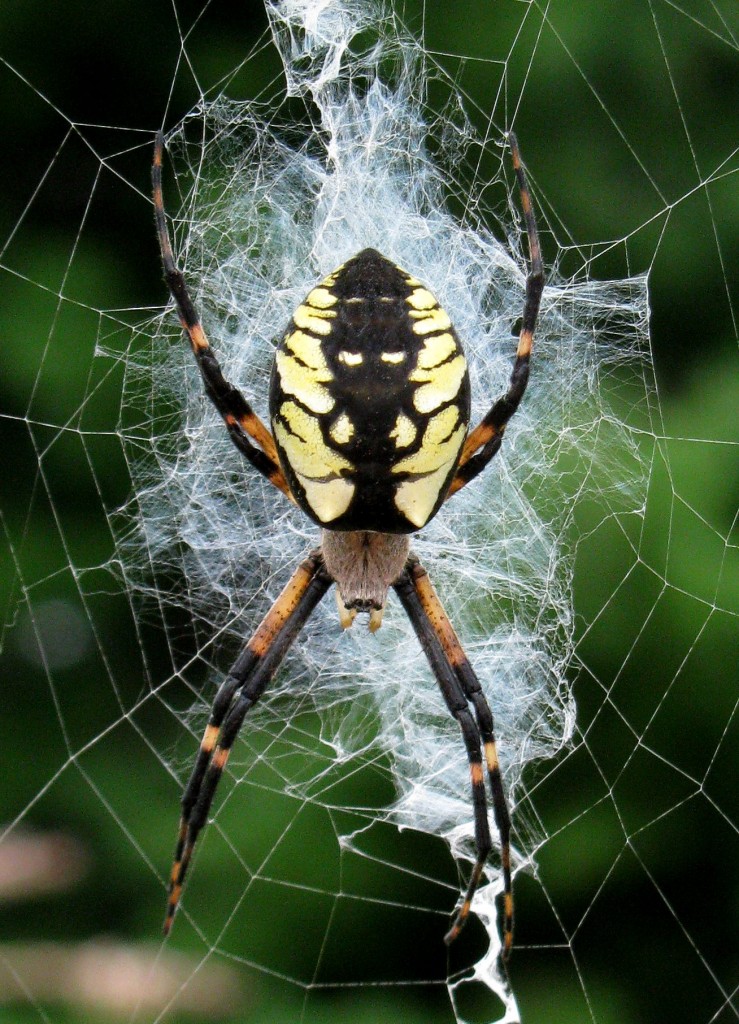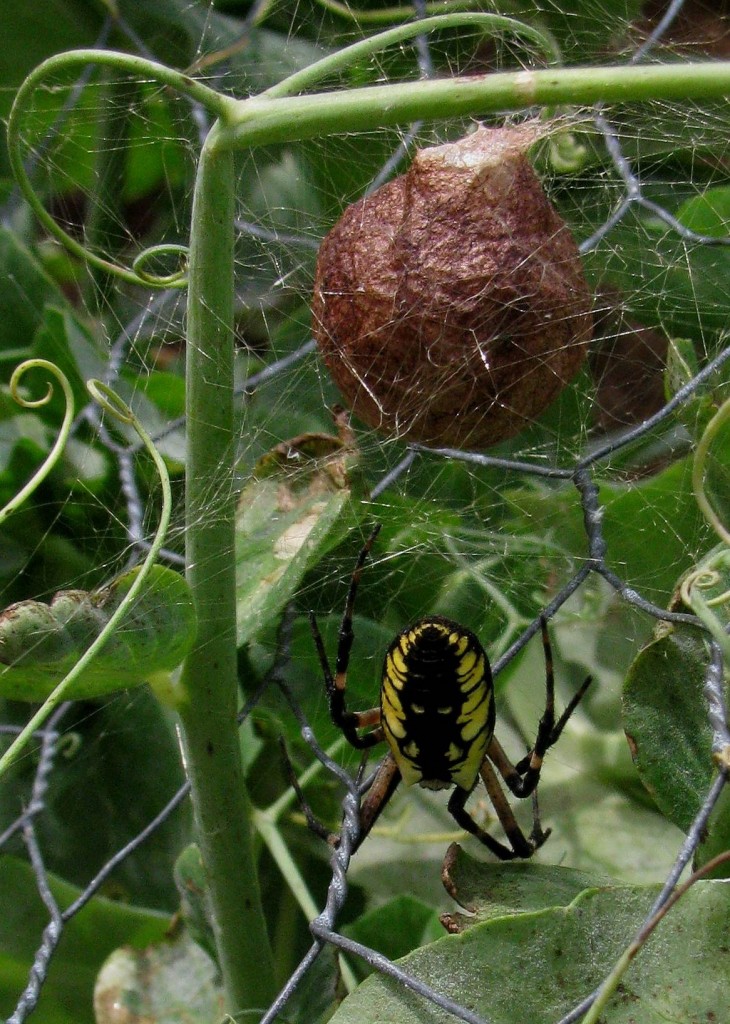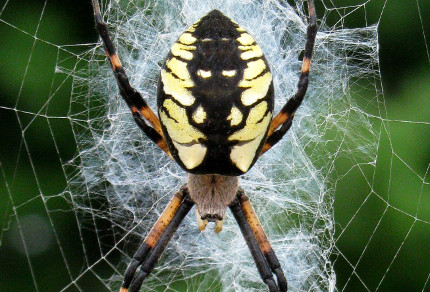
Yellow Garden Spider, Argiope aurantia (© Magi Nams)
A yellow garden spider possesses a sense of timelessness in its appearance – so still and poised, its web bisected by lightning bolts of silk, the arachnid’s appearance itself shouting warnings via its black and yellow colouration. Two days ago, I found a garden spider’s web strung between one corn plant’s leaf and another’s tassel by glistening strands of silk. The web-builder rested motionless on its shimmering creation, completely ignoring me while I photographed it.

Yellow Garden Spider (© Magi Nams)
Today, the spider was gone from its web, which remained attached to the corn plants and didn’t appear to have sustained any obvious damage. Setting my camera aside, I harvested beans and tautly rounded pods of peas, the mid-afternoon late summer sunshine blissfully warm on my shoulders, as though yesterday’s damp coolness were no more than a distant memory. Bulky cicadas flushed from the dense tangles of peavines, and I spotted a large brown spider egg case. The latter was attached by a maze of silk strands to pea tendrils and the thin silver mesh of chickenwire fencing I’d erected in spring to support the burgeoning growth of the peas. Below the suspended egg case, a yellow garden spider rested motionless until I gently tugged a pea tendril out of the way so I could photograph the egg case. The spider seemingly reluctantly shifted its position, then froze into immobility again, as though standing guard over the egg case.

Yellow Garden Spider and Egg Case (© Magi Nams)
Perhaps this is the spider from the corn plant web, or perhaps it’s another. This species, Argiope aurantia, is common in our gardens and fields here in Nova Scotia and occurs throughout much of North America, ranging from southern Canada to Costa Rica.1 Females, like those shown in my photos, are considered to be harmless to humans despite their relatively large size and warning colouration.1 After mating with a much smaller male (which may be transformed into a post-mating meal for the female), a female lays thousands of eggs on a multilayered sheet of silk, which is then wrapped with a tough, brown silk covering, formed into a ball, and suspended from the spider’s web1,2 (or a pea fence, in the case of the spider I observed today). The female does indeed guard her egg case, but only until autumn frosts claim her life.2 My pea plants still have many pods to pick. I’ll see how long she remains.
New Science Word for the Day: stabilimentum = reinforced strands of silk in a spider web (in the case of the yellow garden spider, the lightning bolt or zipper of thick silk).
References:
1. Bug Guide. Iowa State University Entomology. © 2003-2011. Updated 7-Apr-2011. Accessed 9-Sep-2011. http://bugguide.net/node/view/2025
2. Wikipedia. Argiope aurantia. Updated 2-Sep-2011. Accessed 9-Sep-2011. http://en.wikipedia.org/wiki/Argiope_aurantia



Hi Magi, Bryson and I discovered this beauty in our backyard. I automatically think “Yellow and black – stay back!” It had (what looked like) a grasshopper wrapped up rather well. It was still alive and would stretch a leg out a few times. I was tempted to rescue it but thought I’d better not deprive the spider of her supper. Also there was a small white sac that I thought might be eggs but I wasn’t sure. There was a curly strand hanging from it. We decided to come in and google it and yours was the first website that popped up.
Hi, Rozelyn!
This spider truly is gorgeous, isn’t it? Recently, I’ve seen many while out tending my gardens and picking berries. Most had their webs strung between blackberry and raspberry canes, so I tried to avoid damaging their webs while gathering berries. I’m glad that you and Bryson spotted your spider and took the time to observe it. Your description of the captured grasshopper is fascinating! Thanks so much for commenting. – Magi
My husband found one of these spiders in his burning can today, of course he will move it before he uses it again, the legs on him are black and he’s rather big. Myself I am petrified of spiders and my house is my sanctuary, if they come in they either go out or are gone, I’m sorry….I would never hurt a spider outside, we have some others that are yellowish and red , anyone know what they are?
Hi, Cathy,
I’m so glad your husband will move the garden spider out of harm’s way, and I completely understand why your house is your sanctuary. My house is my sanctuary, too, although I do allow a few daddy longlegs to hang out in ceiling corners. Unfortunately, I don’t know the identity of your yellowish-red spider. Perhaps if you post a photograph (not sure if that will work in the comments box), one of my readers might be able to help you out. Or, if you’re on FaceBook, post a picture and ask for help identifying the spider. Thanks for commenting! – Magi